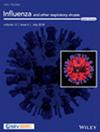Late-Season Influenza Vaccine Effectiveness Against Medically Attended Outpatient Illness, United States, December 2022–April 2023
IF 4.3
4区 医学
Q1 INFECTIOUS DISEASES
引用次数: 0
Abstract
Background
The 2022–23 US influenza season peaked early in fall 2022.
Methods
Late-season influenza vaccine effectiveness (VE) against outpatient, laboratory-confirmed influenza was calculated among participants of the US Influenza VE Network using a test-negative design.
Results
Of 2561 participants enrolled from December 12, 2022 to April 30, 2023, 91 laboratory-confirmed influenza cases primarily had A(H1N1)pdm09 (6B.1A.5a.2a.1) or A(H3N2) (3C.2a1b.2a.2b). Overall, VE was 30% (95% confidence interval −9%, 54%); low late-season activity precluded estimation for most subgroups.
Conclusions
2022–23 late-season outpatient influenza VE was not statistically significant. Genomic characterization may improve the identification of influenza viruses that circulate postinfluenza peak.
2022 年 12 月至 2023 年 4 月美国晚季流感疫苗对门诊就医疾病的有效性。
背景2022-23年美国流感季节在2022年秋季提前达到高峰:方法:采用阴性试验设计,在美国流感疫苗接种网络的参与者中计算了晚季流感疫苗对门诊病人、实验室确诊流感的有效性(VE):在2022年12月12日至2023年4月30日期间注册的2561名参与者中,有91例经实验室确诊的流感病例主要为甲型H1N1 pdm09(6B.1A.5a.2a.1)或甲型H3N2(3C.2a1b.2a.2b)。总体而言,VE 为 30%(95% 置信区间为 -9%,54%);由于晚季活动较少,无法对大多数亚群进行估计:2022-23年流感晚季门诊病人VE在统计学上并不显著。基因组特征描述可提高对流感高峰后流行的流感病毒的识别能力。
本文章由计算机程序翻译,如有差异,请以英文原文为准。
求助全文
约1分钟内获得全文
求助全文
来源期刊
CiteScore
7.20
自引率
4.50%
发文量
120
审稿时长
6-12 weeks
期刊介绍:
Influenza and Other Respiratory Viruses is the official journal of the International Society of Influenza and Other Respiratory Virus Diseases - an independent scientific professional society - dedicated to promoting the prevention, detection, treatment, and control of influenza and other respiratory virus diseases.
Influenza and Other Respiratory Viruses is an Open Access journal. Copyright on any research article published by Influenza and Other Respiratory Viruses is retained by the author(s). Authors grant Wiley a license to publish the article and identify itself as the original publisher. Authors also grant any third party the right to use the article freely as long as its integrity is maintained and its original authors, citation details and publisher are identified.

 求助内容:
求助内容: 应助结果提醒方式:
应助结果提醒方式:


